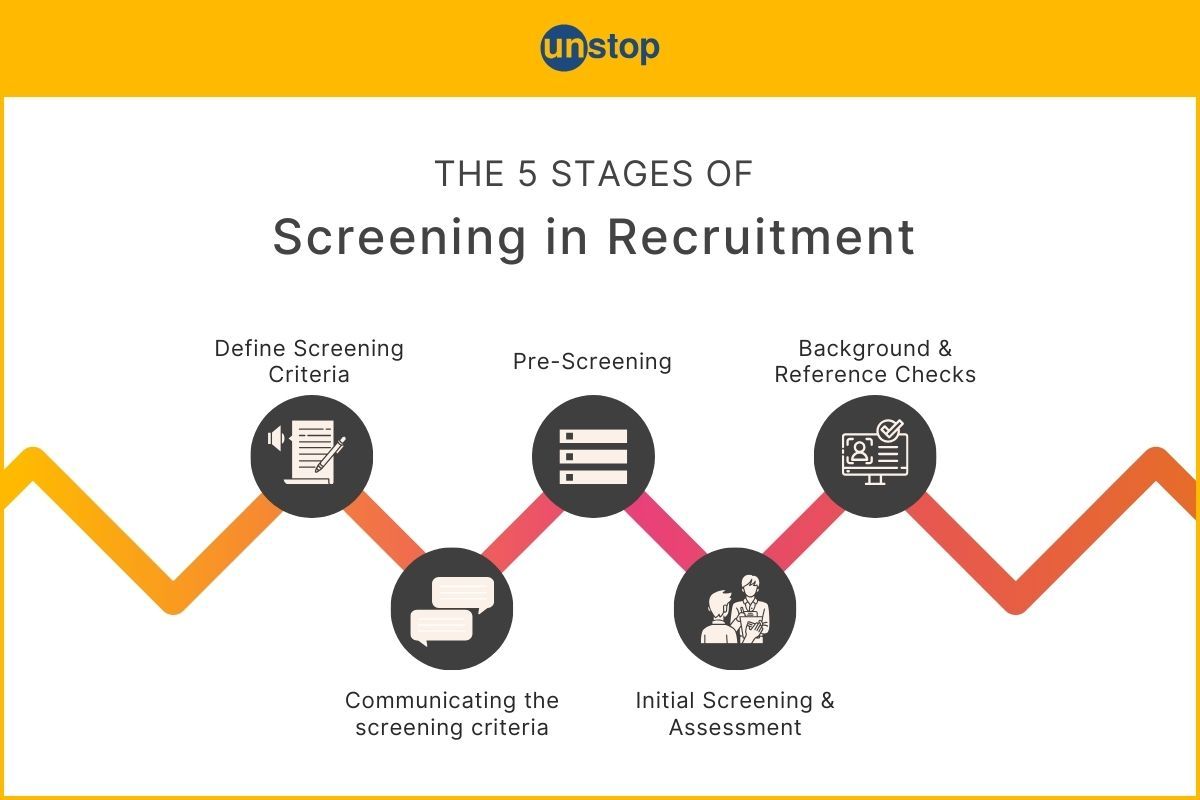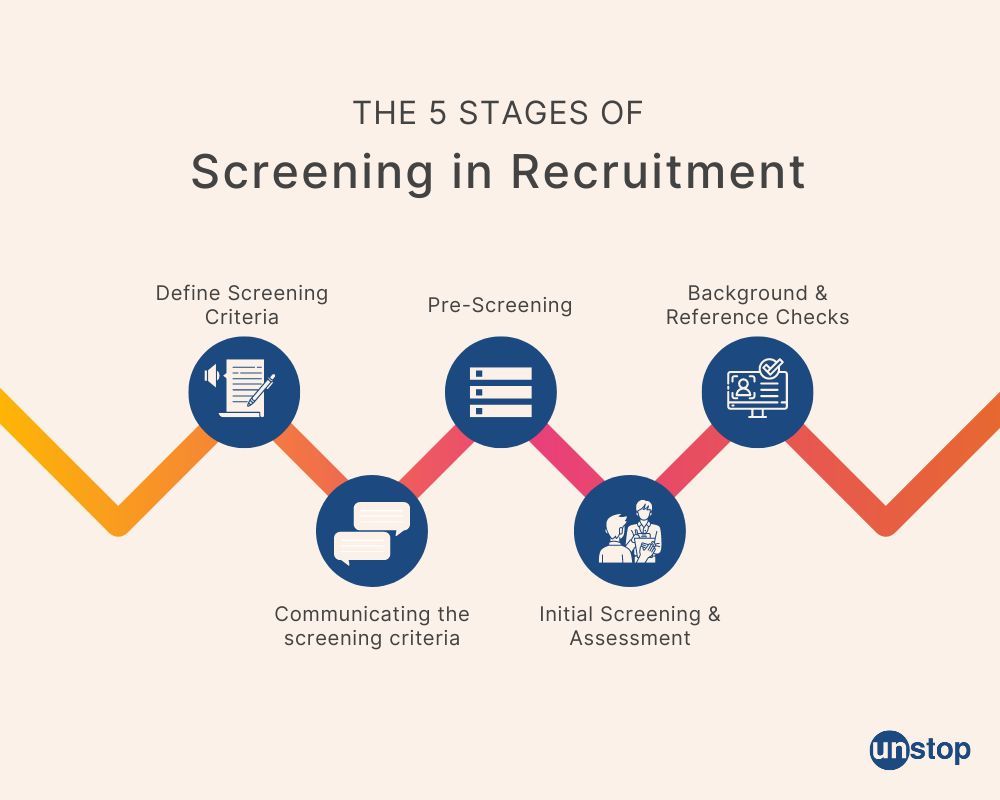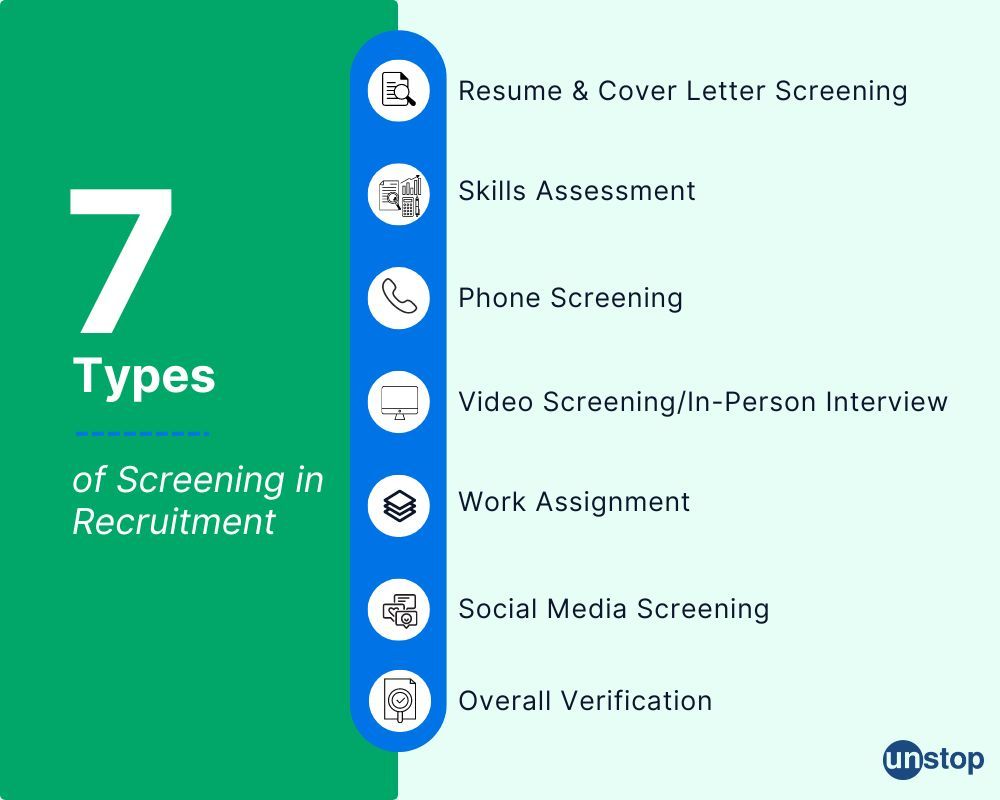- What is Screening in Recruitment?
- Stages of Screening In Recruitment
- Screening Techniques in Recruitment
- Metrics to Evaluate Screening in Recruitment
- Screening in the Recruitment Process: Things to Keep in Mind
- Want a Screening & Recruitment Automation Solution to Meet all Organizational Needs?
Screening In Recruitment: Understand Its Stages, Methods & More

Recruiting the best candidate for the role is one of the most important tasks in any organization. However, it's also one of the most difficult. Crafting a winning recruitment strategy involves several steps. But broadly, these are the 3S of the recruitment process - Sourcing, Screening, and Selection.
Today, we'll dig deeper into the process of screening in recruitment.
What is Screening in Recruitment?
The recruitment process begins with identifying the need for hiring and ends with retaining a new hire for a set period of time (at least a year). The entire process is divided into multiple stages, but one of the most important parts of the recruitment process is screening.
Screening in recruitment is the process of evaluating applications on a pre-defined criteria to select the most suitable candidate for the role, i.e. one who has the educational qualifications, skill set, and requisite experience demanded by the role.
Simply put, screening is the practice of filtering through all job applications to find the right candidate who meets the job requirements. Screening comes right after candidate sourcing in the recruitment process. But it influences the entire hiring process, from the start (when applications are first sought) to the end (when a candidate is hired).
Let's now understand the different stages of the screening process in recruitment in detail.
Stages of Screening In Recruitment

Screening potential candidates is a five-step process. Here's what each stage of screening in recruitment entails:
Stage 1: Defining Screening Criteria
The first step of the candidate screening process is to identify and define the criteria to be used to screen candidates. This involves assessing the job requirements and selecting the skill set. This includes listing both soft skills and technical skills required for the role. Furthermore, at this stage, it's also important to clearly state the must-have skills for the role, as well as the desirable skills.
Stage 2: Communicating the Screening Criteria
The next step is to communicate the screening criteria to potential candidates. This includes drafting a comprehensive job description that clearly communicates the job requirements and essential skills (soft skills and technical knowledge, along with basic educational qualifications and required experience) required for the role.
Stage 3: Pre-Screening
Once you've defined and communicated the screening criteria, you will start receiving applications from interested candidates. However, not every candidate who applies for the role may meet the eligibility criteria. Thus, you need to filter through the candidate pool and select candidates who will advance to the next stage.
There are various techniques to conduct preliminary screening in the selection process, but one of the most common is screening resumes and cover letters for preferred qualifications. This can be done manually or through automated tools.
For example, when digitizing and automating the recruitment process for IndiGo's hiring drive, we included a questionnaire with MCQ-type answers for requirements like location, tattoos (for cabin crew), highest qualification, etc. Our automated screening tools then reviewed the responses to filter out candidates who did not meet the requirements and scored the ones that did against a set rubric. Imagine the time saved through this simple screening exercise?
Stage 4: Initial Screening, Online Assessments, & Interviews
After pre-screening, you arrive at a filtered pool of candidates - but they need to go through a series of talent assessments before they can be hired for the role. This involves screening promising candidates through online assessments tailored for specific skills, roles, or industries. For example, if a candidate is applying for the role of a content writer, you can evaluate their writing skills through a test.
Generally, an efficient process is one where 2-3 different types of screening techniques are used at this stage. For example, conducting a telephonic interview and skill assessment before the final interview process.
You can use Unstop's online assessment platform to find a wide variety of assessment tools. The platform also provides instant scoring powered by AI and provides deep insights in a single dashboard for data-backed decision making.
We also have robust online proctoring solutions that ensure the intergrity of your assessments and other screening stages.
Candidates who qualify from the talent assessment rounds can then move to the interview stage. This structured approach helps reduce the time spent on interviewing unfit candidates and increase the interview-to-hire ratio. In the modern hiring landscape, with the emergence of virtual interviewing platforms and AI-bot solutions, the process of scheduling bulk interviews, conducting them, evaluations, and communication has become seamless.
Stage 5: Background and Reference Check
After screening candidates, organizations make an offer to the selected individual(s). However, before finalizing the offer, it's important to conduct a background and reference check for the selected candidates. This can also include evaluating the candidates' presence on social media.
Screening Techniques in Recruitment

Different screening techniques are used at different stages. Here's a look at some of the most common types of screening in recruitment:
i) Resume & Cover Letter Screening
One of the most common techniques is screening resumes and cover letters. Organizations can use manual and/or automated techniques to evaluate resumes and cover letters. One of the biggest challenges of manually screening resumes is the time taken to go through thousands of resumes. Automated candidate screening tools powered by AI can filter through digital resumes/profiles to shortlist candidates who meet the basic criteria - instantly rejecting other profiles where the minimum qualifications are not met. This helps save valuable time. They also help with blind assessment.
Automated screening of resumes, along with manual screening of cover letters, can help organizations effectively filter through the pool of applicants.
ii) Online Assessments: Skills & Role-Based Tests
Another way to screen candidates is to conduct online talent assessments tailored to specific skills and even role-based assessments. Some common skill tests are MCQs & aptitude tests, communication skills tests, coding assessments, business competency simulation games, etc.
This helps recruiters evaluate the basic competency and skill level of a candidate. Candidates who fail this stage are not fit for the role because they can't meet the job's basic requirements.
iii) Phone Screening
Recruiters can also use a telephonic interview process to gauge a candidate's basic communication skills, interest in the role, salary expectations, etc. A phone interview is usually not a detailed interview. Rather, phone interviews are an attempt to better understand the person behind the resume, finding extra nuggets of information about the candidate that may not be apparent through a resume or cover letter.
iv) Virtual Interviews or Video Screening
Video screening or virtual interviews are usually employed at a later stage of the process in recruitment. Herein, an interviewer or interview panel evaluates the job applicant on various parameters, such as interpersonal skills, technical knowledge, work experience, etc. This also helps recruiters judge an individual's body language.
Video screening is especially important in the case of remote hiring. But it can also be replaced by in-person interviews.
Note: Keep the level and type of interview questions consistent to ensure a fair recruiting process. One solution is to opt for recruitment automation tools that combine all the stages and come with AI-powered features like set templates for evaluation, question bank for assessments/interviews, etc.
v) Work Assignment
Another popular and relevant screening tool or technique is a work assignment. This helps in real-time review of the key skills required for the role. Herein, candidates are expected to complete a particular assignment in a given time frame. For example, a candidate applying for the post of content editor may be asked to edit a set number of articles in 24 hours.
vi) Social Media Screening
Social media screening, i.e., evaluating social media profiles of prospective candidates, has become a common part of the screening process these days. Evaluating an individual's social media profile can help recruiters get a better understanding of the individual - and whether their values align with the company culture. However, this screening is usually conducted for a final pool of candidates, rather than all candidates who apply for the role.
vii) Verifications
This technique is used to verify that the candidate has furnished accurate information about their work and educational history. This includes background checks for credit history, criminal history, etc. Background checks can also include reference checks and vetting documents.
Reference checks help organizations get first-hand information about the selected candidate's performance and attitude from former colleagues and managers. To verify educational background, organizations may ask candidates to submit copies of their degree certificates, etc.
Metrics to Evaluate Screening in Recruitment
Recruiting metrics are used at different stages of the hiring process to evaluate the performance of each stage and identify bottlenecks and improvement areas, if any. The following are some recruiting metrics that are used to evaluate the effectiveness of screening in the hiring process:
Quality of Hire
This metric evaluates the quality of the candidates finally selected for the role. If this is low, it shows there's a gap in the recruitment process or the onboarding process. If a candidate who's not fit for the role makes it through the screening and selection process, it shows a gap in the hiring strategy. But if a candidate is unable to adjust to the new role, but met all the criteria, then organizations need to either revise their criteria and evaluation process or amp up their onboarding technique.
Time to Hire/Time To Fill
Both of these metrics help determine the total time taken to close a vacancy. If the time is too high, then the screening process is not as efficient as required. It could be because the talent pipeline is too wide, or the screening techniques are too time-consuming, or for another reason.
Candidate Experience
This metric helps understand the candidate's experience during the entire process, including screening in recruitment. A positive candidate experience improves your chances of finding the best candidate for the role in the future as well.
Screening in the Recruitment Process: Things to Keep in Mind
There are several recruiting challenges for hiring managers. However, here are simple steps and points that you can follow to improve the efficiency of your screening process:
Use a structured method
A structured method of screening in recruitment can help in smart candidate selection, saving time, improving efficiency, and the overall candidate experience.
Be consistent
It's important that interviewers use consistent candidate screening questions to ensure the process is fair for everyone.
Transparency is important
Make sure that you're transparent in your communication with the candidates. This not only contributes to a positive candidate experience but also helps minimize the chances of mishires.
Keep record
Maintain records - be it taking notes during the interviews or maintaining a list of common mistakes in the process. Having records helps organizations streamline the process.
The job market is flooded with applicants. A strategic and detailed screening process can help find the best candidate from the talent pools.
Want a Screening & Recruitment Automation Solution to Meet all Organizational Needs?
Check out Unstop's full-stack recruitment automation solution, complete with sourcing from a massive community, automated screening powered by AI, diverse online assessments, virtual interviews, and final offers.
You can also reach out to us at coffee@unstop.com for a demo or for any queries you have.
You may also be interested in:
- Understanding Recruitment Funnel Metrics: The Perfect Approach To Measuring Effectiveness Of Hiring
- Step-By-Step Approach To Building A Winning Campus Recruitment Strategy
- What is Campus Recruitment? How To Tap The Untapped Talent?
- Lateral Hiring: A Complete Guide To The Process, Its Benefits, Challenges & Best Practices
I’m a reader first and a writer second, constantly diving into the world of content. If I’m not writing or reading, I like watching movies and dreaming of a life by the beach.
Login to continue reading
And access exclusive content, personalized recommendations, and career-boosting opportunities.
Subscribe
to our newsletter
Blogs you need to hog!

Organize Hackathons: The Ultimate Playbook With Past Case Studies

What is Campus Recruitment? How To Tap The Untapped Talent?

Lateral Hiring: A Complete Guide To The Process, Its Benefits, Challenges & Best Practices













Comments
Add comment